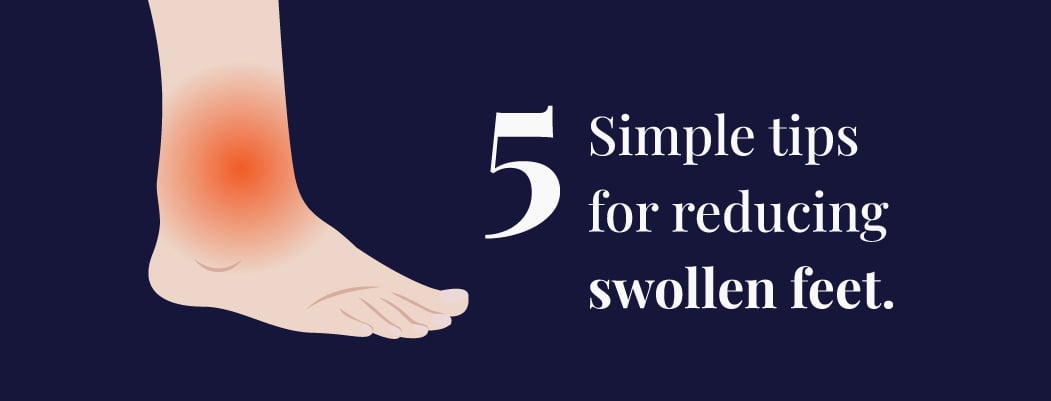How to reduce swelling in feet
March 2, 2023

What is known as swelling in feet?
Swelling in the feet is a common problem, especially among people who have to stand or sit for long hours or those who are overweight. In medical terms, this condition is known as peripheral oedema, caused by fluid accumulation in the tissues of the feet and ankles. Swollen feet can cause discomfort and pain and even interfere with daily activities. Fortunately, there are several home remedies that you can use to reduce swelling in your feet.
Contents
Causes of Swollen Feet
Swollen feet can be caused by a variety of factors. Here are some of the most common causes:
- Prolonged standing or sitting: When you stand or sit for long periods, gravity can cause fluid to accumulate in your feet and ankles, leading to swelling.
- Injury: An injury to your foot or ankle can cause swelling.
- Obesity: Being overweight can put extra pressure on your feet and cause them to swell.
- Pregnancy: Pregnant women often experience swollen feet due to hormonal changes and increased pressure on their legs and feet.
- Certain medications: Some medications, such as blood pressure medications, can cause swelling in the feet as a side effect.
Symptoms of Swollen Feet
The symptoms of swollen feet may vary depending on the underlying cause, but some common symptoms include:
- Swelling in the feet, ankles, and legs
- Pain or discomfort in the affected area
- Skin that feels tight or stretched
- Reduced mobility or difficulty walking
- Discolouration of the skin, such as redness or purple tint
Home remedies for swollen feet
- Elevation: Elevating your feet is a simple and effective way to reduce swelling in your feet. You can lie down and elevate your feet above your heart level using pillows or use a footstool to elevate your feet while sitting. By doing so, you help the excess fluid to move away from your feet and towards your heart, where it can be eliminated through the kidneys and bladder.
- Compression: Compression socks or stockings can help reduce swelling by squeezing the tissues in the feet and legs, which increases blood flow and lymphatic drainage. You can find compression socks at most drugstores or online. It is important to ensure you get the correct size for your feet and avoid wearing them for too long or too tight, as it can cause discomfort or harm.
- Massage: Massaging your feet and ankles can help stimulate circulation, reduce inflammation and relieve pain. You can use your hands to gently rub the affected area or use a massage ball or roller. Make sure to apply gentle pressure and avoid rubbing too hard, as it can cause further damage. You can also add essential oils such as peppermint or lavender to your massage oil or lotion, as they can help reduce inflammation and soothe sore muscles.
- Exercise: Gentle exercise can help improve circulation and reduce swelling. Walking, yoga, swimming, and cycling are some low-impact exercises that can be helpful. Exercise helps stimulate blood circulation and lymphatic fluid, which can help reduce swelling. It is important to start slowly and gradually increase the intensity of the exercise as tolerated.
- Hydration: Drinking plenty of water is essential to help flush out excess fluid and reduce swelling. When the body is dehydrated, it tends to retain more fluid, leading to swelling. Drinking water can help to keep the body hydrated and maintain the balance of fluids.
- Salt intake: Reducing salt intake can help prevent fluid retention, which can lead to swelling. Salt contains sodium, which can cause the body to retain water. Therefore, it is important to limit the intake of processed foods containing high amounts of sodium.
- Diet: Eating a healthy diet rich in fruits and vegetables can help reduce inflammation and improve circulation. Fruits and vegetables contain antioxidants, which can help reduce inflammation and swelling. Foods high in omega-3 fatty acids, such as fish, nuts, and seeds, can also be helpful in reducing inflammation.
- Ice: Applying ice to the affected area can help reduce swelling and relieve pain. You can wrap a cold or ice pack in a towel and apply it to the affected area for 10-15 minutes. This can be repeated several times a day.
When to see a doctor for swollen feet?
If your legs suddenly start to swell, consult with a podiatrist, particularly if you are also experiencing chest pain, trouble breathing, or other symptoms that could indicate a heart condition or blood clot in your lungs.
People also ask
-
What is the fastest way to reduce swelling in feet?
The fastest way to reduce swelling in the feet is by elevating them above the heart level, which helps to reduce blood flow to the area and decrease inflammation. You can also apply ice packs or a cold compress to the affected area for 15-20 minutes at a time, several times a day. Wearing compression socks or stockings may also help to reduce swelling.
-
How can you get rid of swollen feet?
In addition to the methods mentioned above, you can also try exercising or stretching your legs and feet, improving circulation and reducing swelling. Drinking plenty of water can also help flush out excess fluid in the body that may contribute to swelling. Avoiding salt and consuming foods high in potassium, such as bananas and avocados, may also help to reduce swelling.
-
How do I know if my foot swelling is serious?
Foot swelling can be a symptom of a serious medical condition, such as heart, liver, or kidney disease, so it’s important to consult a healthcare provider if the swelling is severe, sudden, or accompanied by other symptoms such as chest pain, shortness of breath, or difficulty breathing. Other signs that foot swelling may be serious include redness, warmth, or tenderness in the affected area or if the swelling does not improve with self-care measures.
-
How long does it take for foot swelling to go down?
The duration of foot swelling depends on the underlying cause. In some cases, such as standing for long periods or during pregnancy, the swelling may resolve on its own within a few hours to a few days. In other cases, such as an injury or medical condition, the swelling may take several weeks or months to go down. If the swelling persists or worsens, seeking medical attention is important.








